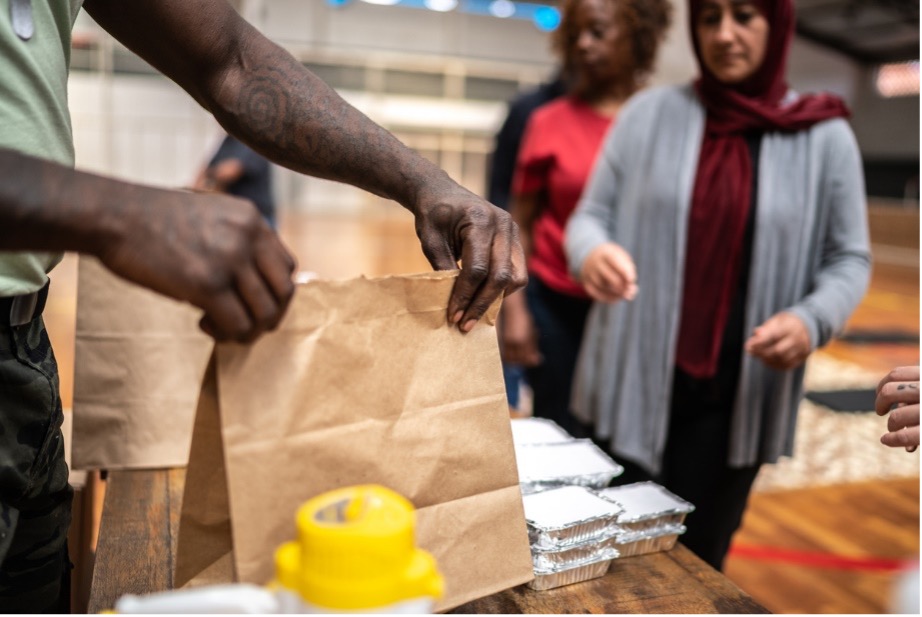Understanding the Myths and Realities of Homelessness
November 12, 2024

Shedding light on the myths and realities surrounding homelessness and hunger, offering a clearer understanding of the support needed to build lasting stability.
Unfortunately, many individuals in our communities face both housing instability and hunger, which are deeply interconnected challenges. Without stable housing, access to food becomes increasingly uncertain, and hunger becomes a constant concern. The focus on finding the next meal makes it even harder to plan for long-term housing stability.
Hunger and Homelessness Awareness Week, which occurs November 17-23, provides an annual opportunity to confront some common misconceptions about homelessness and understand how its interconnectedness with hunger impacts and often impedes the journey to stability, leads to stigma, and ultimately compounds the difficulty individuals face in seeking support.
In this blog, we’ll explore how hunger and homelessness are intertwined and debunk some common myths about these challenges.
Myths about homelessness
Myth #1: Homelessness is a Choice
Reality: Homelessness is rarely a simple choice. Rather, it’s usually the result of a complex combination of factors such as loss of employment, medical emergencies, mental health challenges, and lack of affordable housing. Many individuals fall into homelessness due to unexpected crises or systemic issues beyond their control. In Denver, for example, homelessness has increased by approximately ten percent just in the last year, highlighting the growing challenges in securing stable housing and the worsening housing affordability crisis.
Myth #2: People Experiencing Homelessness Don’t Work
Reality: A significant number of individuals experiencing homelessness hold jobs, and often multiple part-time positions. Despite being employed, many still struggle with the high cost of living, especially in cities with expensive rental markets. Denver is one of the cities where a minimum wage job simply does not cover the cost of living.
In 2022, the median rent for a one-bedroom in Denver jumped 15 percent in a single year, up to an average of $1,610 per month. Additionally, the expiration of several key pandemic-era relief programs, including the expanded child tax credit, has caused a steep increase in the number of Americans experiencing poverty. This number currently hovers at an estimated 40 million Americans.
Myth #3: Hunger and Homelessness Are Separate Issues
Reality: Hunger and homelessness are deeply interconnected. For someone without stable housing, food insecurity is a constant reality that can make it difficult to make long-term plans. In survival mode, finding the next meal often takes precedence over other needs, further complicating any path to stability. Additionally, someone experiencing homelessness rarely has safe ways of storing food, making it nearly impossible to plan beyond the next meal. Hunger Free Colorado reports that 11 percent of Coloradans struggle with reliable access to nutritious food.
Myth #4: Homelessness Is a Permanent Situation
Reality: Homelessness can be temporary, but timely support can make a key difference for people trying to end the cycle of homelessness. For example, RMHS’s Homes for All Veterans (HAV) program has shown that when essential supports are provided—such as housing navigation, mental health services, and access to food—the timeline for securing housing can be reduced by nearly 20 percent. Programs like HAV don’t just place people in homes; they offer a sustainable support system that can make the transition back to stability quicker and more permanent.
Myth #5: Most People Experiencing Hunger and Homelessness are Addicts
Reality: Although substance abuse can be a factor for some, many people experiencing homelessness do not struggle with addiction. Research indicates that mental illness, lack of affordable housing, and unemployment are far more common causes. Many individuals simply need support and resources to get back on their feet.
Breaking the Cycle of Hunger and Homelessness
Addressing homelessness requires more than just providing shelter—it’s about providing a comprehensive support network to help people stabilize and regain independence.
At Rocky Mountain Human Services (RMHS), we understand the importance of addressing both hunger and homelessness in tandem. That’s why, through our programs and in collaboration with local partners, we provide essential support for individuals facing these struggles to empower them toward a brighter future
RMHS programs, like Mission Supports, helps individuals with intellectual and developmental disabilities who are experiencing homelessness gain access to appropriate disability benefits and services, and Homes for All Veterans connects veterans experiencing housing instability to housing, mental health support, and essential resources. Both programs are designed to provide pathways to long-term stability.
Helping Our Community Thrive This Holiday Season and Beyond
As we recognize Hunger and Homelessness Awareness Week, remember that homelessness and hunger impact people in ways that go beyond the lack of food or shelter; they touch on dignity, stability, and hope. RMHS, together with local partners, is dedicated to ensuring every individual in our community has the support needed to break out of the cycle of homelessness. By addressing both hunger and housing insecurity, we aim to empower those facing these challenges to lead fulfilling, stable lives.
For resources on food support and holiday assistance in November and December, view, download, and share the RMHS Holiday Resource Guide. Together, we can make a difference, combat misconceptions, and foster a compassionate approach to helping individuals find their way out of homelessness.







